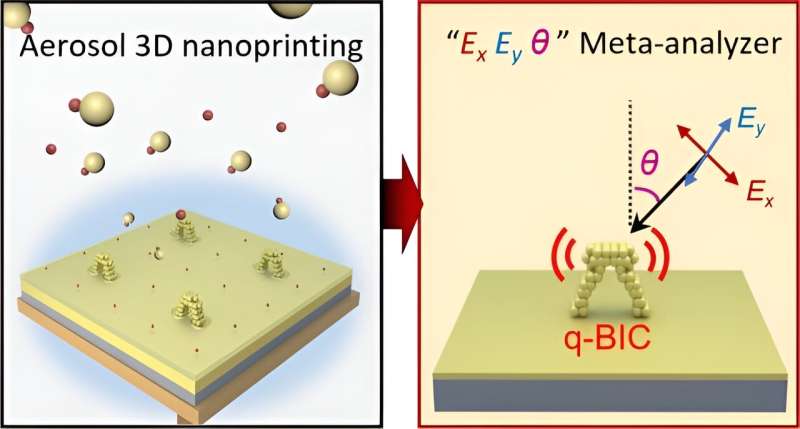This article has been reviewed according to Science X's editorial process and policies. Editors have highlighted the following attributes while ensuring the content's credibility:
fact-checked
peer-reviewed publication
trusted source
proofread
Team uses 3D aerosol nanoprinting to enhance metamaterial performance

A research team has developed a metamaterial capable of detecting the polarization and direction of light through 3D aerosol nanoprinting. Their study was featured in ACS Nano.
Led by Professor Junsuk Rho from the Department of Mechanical Engineering, the Department of Chemical Engineering, and the Department of Electrical Engineering and Ph.D. candidates Younghwan Yang and Hongyoon Kim from the Department of Mechanical Engineering at Pohang University of Science and Technology (POSTECH), and others, the work signifies a breakthrough in the manipulation of light using metamaterials that are widely used in applications such as lenses and holograms.
Specifically, three-dimensional metamaterials leverage three-dimensional metal structures to collect and emit light in a manner similar to antennas, maximizing the interaction between light and matter. This innovative technology is poised to overcome the limitations of conventional optical devices.
Currently, much of the research is focused on two-dimensional metal structures which are relatively simple to design and manufacture. However, these structures are confined to a fixed plane, limiting their ability to diversify and optimize the optical properties of metasurfaces.
By creating metal nanostructures in three dimensions rather than two, different mechanisms for optical responses within a single nanostructure can be implemented. These three-dimensional metal nanostructures enable the integration of various optical properties into a single metamaterial, thereby facilitating the development of multifunctional optical sensors.
In their study, the team utilized "3D aerosol nanoprinting technology" to mass-produce three-dimensional nanostructures of any desired shape from airborne metal nanoaerosols in a parallel manner by controlling an electric field. This technique allowed them to precisely position, assemble, and create 3D metal nanostructures resembling the shape of "pi (π)" under typical temperature and pressure conditions.
The experiments demonstrated that the team's three-dimensional metal nanostructures exhibited two distinct optical phenomena simultaneously: "localized surface plasmon resonance (LSPR)" and "quasi-bound states in the continuum (q-BIC)".
LSPR involves the interaction of free electrons on the surface of a metallic structure with light, causing these electrons to resonate with specific electromagnetic waves. On the other hand, q-BIC is a phenomenon where light becomes trapped in a metal nanostructure.
In a well-defined state, such as when light is incident vertically, there is minimal interaction with the structure. However, under specific conditions, such as when light is incident at an angle, a uniquely shaped energy mode is formed, causing the light to appear bound to the structure.
These dual optical properties enable high-performance optical sensing by enhancing sensor sensitivity while maintaining resonance. While each phenomenon has been studied individually, the combination of both in a single structure has not been previously demonstrated.
The team also achieved a breakthrough by employing a technique known as "Numerical Aperture-Detective Polarimetry." This method combines pi-shaped metal nanostructures with a conventional Fourier transform infrared spectrometer to simultaneously detect the polarization of light and the angle of its incidence.
This capability enables precise analysis of light distribution by efficiently collecting light, providing a more detailed understanding of its polarization and direction compared to previous methods.
Professor Junsuk Rho of POSTECH said, "This advancement will benefit various fields such as optical filtering, ultra-sensitive biosensing, and environmental monitoring."
Younghwan Yang said, "Our ongoing research aims to further develop and commercialize this technology, facilitating more precise and rapid optical analysis systems."
More information: Younghwan Yang et al, Angle-Resolved Polarimetry with Quasi-Bound States in the Continuum Plasmonic Metamaterials via 3D Aerosol Nanoprinting, ACS Nano (2024). DOI: 10.1021/acsnano.3c12024
Journal information: ACS Nano
Provided by Pohang University of Science and Technology




















